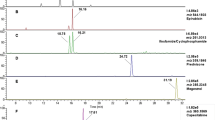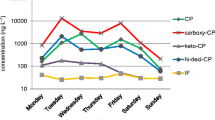Abstract
Background, aim, and scope
According to the high incidence of cancer worldwide, the amount of cytostatic drugs administered to patients has increased. These compounds are excreted to wastewaters, and therefore become potential water contaminants. At this stage, very little is known on the presence and elimination of cytostatic compounds in wastewater treatment plants (WWTP). The aim of this study was to develop a liquid chromatography–high-resolution mass spectrometry (LC–Orbitrap–MS) method for the determination of cyclophosphamide and epirubicin in wastewaters. These compounds represent two outmost used cytostatic agents.
Materials and methods
Extraction and analytical conditions were optimized for cyclophosphamide and epirubicin in wastewater. Both solid-phase extraction using Oasis 200 mg hydrophilic–lipophilic balanced (HLB) cartridges and direct injection analysis were evaluated. Mass spectral characterization and fragmentation conditions were optimized at 50,000 resolving power (full width at half maximum, m/z 200) to obtain maximum sensitivity and identification performance. Quality parameters (recoveries, limits of detection, and repetitivity) of the methods developed were determined, and best performance was obtained with direct water analysis of the centrifuged wastewater. Finally, this method was applied to determine the presence of cyclophosphamide and epirubicin in wastewaters from a hospital effluent, an urban effluent, and influents and effluents from three WWTP.
Results and discussion
Cyclophosphamide and epirubicin were recovered after 50 mL preconcentration on solid-phase extraction 200 mg Oasis HLB cartridges (87% and 37%, respectively), and no breakthrough was observed by extracting 500 mL of water. Limits of detection were of 0.35 and 2.77 ng/L for cyclophosphamide and epirubicin, respectively. On the other hand, direct injection of water spiked at 1 μg/L provided recoveries of 107% for cyclophosphamide and 44% for epirubicin and limits of detection from 3.1 to 85 ng L−1, respectively. The analysis of wastewaters using direct injection analysis revealed the presence of cyclophosphamide and epirubicin in WWTP influents and hospital and urban effluents at levels ranging from 5.73 to 24.8 μg L−1.
Conclusions
The results obtained in this study demonstrate the capability of LC–Orbitrap–MS for accurate trace analysis of these very polar contaminants. This method permitted to identify cyclophosphamide and epirubicin in wastewaters and influents of WWTP, but no traces were detected in WWTP effluents. The methodology herein developed is sensitive and robust and applicable for screening of a large number of samples since no preconcentration is needed.


Similar content being viewed by others
References
Buerge IJ, Buser HR, Poiger T, Müller MD (2006) Occurrence and fate of the cytostatic drugs cyclophosphamide and ifosfamide in wastewater and surface waters. Environ Sci Technol 40:7242–7250
Busetti F, Linge KL, Heitz A (2009) Analysis of pharmaceuticals in indirect potable reuse systems using solid-phase extraction and liquid chromatography-tandem mass spectrometry. J Chromatogr A 1216:5807–5818
Castiglioni S, Zuccato E, Fanelli R, de Voogt P, Emke E, Helmus R, Panteliadis P, Van Leerdam JA (2011). doi:10.1002/9781118000816.ch5.
DiFrancesco R, Griggs JJ, Donnelly J, DiCenzo R (2007) Simultaneous analysis of cyclophosphamide, doxorubicin and doxorubicinol by liquid chromatography coupled to tandem mass spectrometry. J Chromatogr B 852:545–553
Ensslin AS, Stoll Y, Pethran A, Pfaller A, Römmelt H, Fruhmann G (1994) Biological monitoringof cyclophosphamide and ifosfamide in urine of hospital personnel occupationally exposed to cytostatic drugs. Occup Environ Med 51:229–233
Fahmy OT, Korany MA, Maher HM (2004) High performance liquid chromatographic determination of some co-administered anticancer drugs in pharmaceutical preparations and spiked human plasma. J Pharm Biomed Anal 34:1099–1107
Fernandez MP, Noguerol TN, Lacorte S, Buchanan I, Piña B (2009) Toxicity identification fractionation of environmental estrogens in waste water and sludge using gas and liquid chromatography coupled to mass spectrometry and recombinant yeast assay. Anal Bioanal Chem 393:957–968
Floridia L, Pietropaolo AM, Tavazzani M, Rubino FM, Colombi A (1999) High-performance liquid chromatography of methotrexate for environmental monitoring of surface contamination in hospital departments and assesment of occupational exposure. J Chromatogr B 726:95–103
Gómez MJ, Martínez Bueno MJ, Lacorte S, Fernández-Alba AR, Agüera (2007) A pilot survey monitoring pharmaceuticals and related compounds in a sewage treatment plant located on the Mediterranean coast. Chemosphere 66:993–1002
Hogenboom AC, Van Leerdam JA, De Voogt P (2009) Accurate mass screening and identification of emerging contaminants in environmental samples by liquid chromatography-hybrid linear ion trap Orbitrap mass spectrometry. J Chromatogr A 1216:510–519
Hsieh Y, Duncan CJG, Brisson JM (2007) An ion-pairing liquid chromatography/tandem mass spectrometric method for the determination of cytarabine in mouse plasma. Rapid Commun Mass Spectrom 21:629–634
Johnson AC, Jürgens MD, Williams RJ, Kümmerer K, Kortenkamp A, Sumpter JP (2008) Do cytotoxic chemotherapy drugs discharged into rivers pose a risk to the environment and human health? An overview and UK case study. J Hydrol 348:167–175
Kasel D, Jetter A, Harlfinger S, Gebhardt W, Fuhr U (2004) Quantification of cyclophosphamide and its metabolites in urine using liquid chromatography/tandem mass spectrometry. Rapid Commun Mass Spectrom 18:1472–1478
Kiffmeyer T, Götze HJ, Jursch M, Lüders U (1998) Trace enrichment, chromatographic separations and biodegradation of cytostatic compounds in surface water. Fresenius’ J Anal Chem 361:185–191
Kosjek T, Heath E (2011) Occurrence, fate and determination of cytostatic pharmaceuticals in the environment. Trends Anal Chem 30:1065–1087
Kovalova L, McArdell CS, Hollender J (2009) Challenge of high polarity and low concentrations in analysis of cytostatics and metabolites in wastewater by hidrophilic interaction chromatography/tandem mass spectrometry. J Chromatogr A 1216:1100–1108
Kümmerer K (2001) Drugs in the environment: emission of drugs, diagnostic aids and disinfectants into wastewater by hospitals in relation to other sources. Chemosphere 45:957–969
Llewellyn N, Lloyd P, Jürgens MD, Johnson AC (2011) Determination of cyclophosphamide and ifosfamide in sewage effluent by stable isotope-dilution liquid chromatography-tandem mass spectrometry. J Chromatogr A 1218:8519–8528
Mahnik SN, Rizovski B, Fuerhacker M, Mader RM (2004) Determination of 5-fluorouracil in hospital effluents. Anal Bioanal Chem 380:31–35
Mahnik SN, Rizovski B, Fuerhacker M, Mader RM (2006) Development of an analytical method for the determination of anthracyclines in hospital effluents. Chemosphere 65:1419–1425
Mahnik SN, Lenz K, Weissenbacher N, Mader RM, Fuerhacker M (2007) Fate of 5-fluorouracil, doxorubicin, epirubicin, and daunorubicin in hospital wastewater and their elimination by activated sludge and treatment in a membrane-bio-reactor system. Chemosphere 66:30–37
Nussbaumer S, Fleury-Souverain S, Antinori P, Sadeghipour F, Hochstrasser DF, Bonnabry P, Veuthey JL, Geiser L (2010) Simultaneous quantification of ten cytotoxic drugs by a validated LC-ESI-MS/MS method. Anal Bional Chem 398:3033–3042
Perry RH, Cooks RG, Noll RJ (2008) Orbitrap mass spectrometry: instrumentation, ion motion and applications. Mass Spectrom Rev 27:661–699
Pisano R, Breda M, Grassi S, James CA (2005) Hydrophilic interaction liquid chromatography-APCI-mass spectrometry determination of 5-fluorouracil in plasma and tissues. J Pharm Biomed Anal 38:738–745
Ribes J, Claries R, Buxó M, Ameijide A, Valls J, Gispert R (2008) Predictions of cancer incidence and mortality in Catalonia to 2015 by means of Bayesian models. Med Clin 131:32–41
Richardson SD (2010) Environmental mass spectrometry: emerging contaminants and current issues. Anal Chem 82:4742–4774
Schröder HF, Gebhardt W, Thevis M (2010) Anabolic, doping, and lifestyle drugs, and selected metabolites in wastewater—detection, quantification, and behaviour monitored by high-resolution MS and MS(n) before and after sewage treatment. Anal Bioanal Chem 398:1207–1229
Sottani C, Rinaldi P, Leoni E, Poggi G, Teragni C, Delmonte A, Minoia C (2008) Simultaneous determination of cyclophosphamide, ifosfamide, doxorubicin, epirubicin and daunorubicin in human urine using high-performance liquid chromatography/electrospray ionization tandem mass spectrometry: bioanalytical method validation. Rapid Commun Mass Spectrom 22:2645–2659
Sottani C, Leoni E, Porro B, Montagna B, Amatu A, Sottotetti F, Quaretti P, Poggi G, Minoia C (2009) Validation of an LC–MS/MS method for the determination of epirubicin in human serum of patients undergoing drug eluting microsphere-transarterial chemoembolization (DEM-TACE). J Chromatogr B 877:3543–3548
Tauxe-Wuersch A, De Alencastro LF, Grandjean D, Tarradellas J (2006) Trace determination of tamoxifen and 5-fluorouracil in hospital and urban wastewaters. Int J Env Anal Chem 86:473–485
Weissbrodt D, Kovalova L, Ort C, Pazhepurackel V, Moser R, Hollender J, Siegrist H, McArdell CS (2009) Mass flows of X-ray contrast media and cytostatics in hospital wastewater. Environ Sci Technol 43:4810–4817
Yin J, Shao J, Zhang J, Li K (2010) A preliminary study on the occurrence of cytostatic drugs in hospital effluents in Beijing, China. Bull Environ Contam Toxicol 84:39–45
Acknowledgments
Gabriela Poch is acknowledged for logistic/administrative support. The Catalan Water Agency and the Spanish Ministry of Science and Innovation project [CTQ2011-25875] are acknowledged for financial support. The Institut Català d’Oncologia (ICO) is also acknowledged for supplying the information on the cytostatic compounds administered.
Author information
Authors and Affiliations
Corresponding author
Additional information
Responsible editor: Philippe Garrigues
Rights and permissions
About this article
Cite this article
Gómez-Canela, C., Cortés-Francisco, N., Oliva, X. et al. Occurrence of cyclophosphamide and epirubicin in wastewaters by direct injection analysis–liquid chromatography–high-resolution mass spectrometry. Environ Sci Pollut Res 19, 3210–3218 (2012). https://doi.org/10.1007/s11356-012-0826-z
Received:
Accepted:
Published:
Issue Date:
DOI: https://doi.org/10.1007/s11356-012-0826-z




